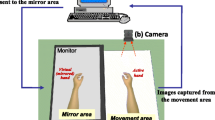Abstract
The action of observing can be used as an effective rehabilitation paradigm, because it activates the mirror neuron system. However, it is difficult to fully use this paradigm because it is difficult to get patients to engage in watching video clips of exercise. In this study, we proposed a steady state visually evoked potential (SSVEP) based paradigm that could be used in a Brain Computer Interface, and examined its feasibility by investigating whether flickering video could activate the mirror neuron system and evoke SSVEPs at the same time. Twenty subjects were recruited and asked to watch the flickering videos at a rate of 20 Hz of upper limb motion and visual white noise, while an EEG signal was recorded. The mu rhythm (8–13 Hz) suppression and the SSVEP (19–21 Hz) evocation were analyzed from recorded EEG. The results showed that SSVEPs, evoked by the flickering stimulus, was observed in both conditions on O1 and O2, but the mu rhythm suppression on C3 and C4 was observed only in the exercise video condition. These results could signify that the flickering video is applicable for the BCI rehabilitation game, activating the mirror neuron system at the same time.




Similar content being viewed by others
References
Liepert J, Bauder H, Wolfgang HR, Miltner WH, Taub E, Weiller C. Treatment-induced cortical reorganization after stroke in humans. Stroke. 2000;31(6):1210–6.
Mulder T, de Vries S, Zijlstra S. Observation, imagination and execution of an effortful movement: more evidence for a central explanation of motor imagery. Exp Brain Res. 2005;163(3):344–51.
Musicco M, Emberti L, Nappi G, Caltagirone C, Italian P. Multicenter study on outcomes of rehabilitation of neurological, early and long-term outcome of rehabilitation in stroke patients: the role of patient characteristics, time of initiation, and duration of interventions. Arch Phys Med Rehabil. 2003;84(4):551–8.
Rizzolatti G, Fadiga L, Matelli M, Bettinardi V, Paulesu E, Perani D, Fazio F. Localization of grasp representations in humans by PET: 1 observation versus execution. Exp Brain Res. 1996;111(2):246–52.
Jackson PL, Lafleur MF, Malouin F, Richards C, Doyon J. Potential role of mental practice using motor imagery in neurologic rehabilitation. Arch Phys Med Rehabil. 2001;82(8):1133–41.
Ertelt D, Small S, Solodkin A, Dettmers C, McNamara A, Binkofski F, Buccino G. Action observation has a positive impact on rehabilitation of motor deficits after stroke. Neuroimage. 2007;36(Suppl 2):T164–73.
Johansson BB. Current trends in stroke rehabilitation. A review with focus on brain plasticity. Acta Neurol Scand. 2011;123(3):147–59.
Carvalho D, Teixeira S, Lucas M, Yuan TF, Chaves F, Peressutti C, Machado S, Bittencourt J, Menendez-Gonzalez M, Nardi AE, Velasques B, Cagy M, Piedade R, Ribeiro P, Arias-Carrion O. The mirror neuron system in post-stroke rehabilitation. Int Arch Med. 2013;6(1):41.
Lago-Rodriguez A, Lopez-Alonso V, Fernandez-del-Olmo M. Mirror neuron system and observational learning: behavioral and neurophysiological evidence. Behav Brain Res. 2013;248:104–13.
Newman-Norlund RD, van Schie HT, van Zuijlen AM, Bekkering H. The mirror neuron system is more active during complementary compared with imitative action. Nat Neurosci. 2007;10(7):817–8.
Zhang R, Wang Q, Li K, He S, Qin S, Feng Z, Chen Y, Song P, Yang T, Zhang Y, Yu Z, Hu Y, Shao M, Li Y. A BCI-based environmental control system for patients with severe spinal cord injuries. IEEE Trans Biomed Eng. 2017.
Gao X, Xu D, Cheng M, Gao S. A BCI-based environmental controller for the motion-disabled. IEEE Trans Neural Syst Rehabil Eng. 2003;11(2):137–40.
Kim DW, Lee JC, Park YM, Kim IY, Im CH. Auditory brain-computer interfaces (BCIs) and their practical applications. Biomed Eng Lett. 2012;2(1):13–7.
Morgan ST, Hansen JC, Hillyard SA. Selective attention to stimulus location modulates the steady-state visual evoked potential. Proc Natl Acad Sci USA. 1996;93(10):4770–4.
Babiloni C, Carducci F, Cincotti F, Rossini PM, Neuper C, Pfurtscheller G, Babiloni F. Human movement-related potentials vs desynchronization of EEG alpha rhythm: a high-resolution EEG study. Neuroimage. 1999;10(6):658–65.
Cochin S, Barthelemy C, Lejeune B, Roux S, Martineau J. Perception of motion and qEEG activity in human adults. Electroencephalogr Clin Neurophysiol. 1998;107(4):287–95.
Oztop E, Arbib MA. Schema design and implementation of the grasp-related mirror neuron system. Biol Cybern. 2002;87(2):116–40.
Perry A, Bentin S. Mirror activity in the human brain while observing hand movements: a comparison between EEG desynchronization in the mu-range and previous fMRI results. Brain Res. 2009;1282:126–32.
Acknowledgements
This work was supported by the National Research Foundation of Korea (NRF) grant funded by the Korea government (MSIP) (No. NRF-2017R1A2B4011920).
Author information
Authors and Affiliations
Corresponding author
Rights and permissions
About this article
Cite this article
Lim, H., Ku, J. Flickering exercise video produces mirror neuron system (MNS) activation and steady state visually evoked potentials (SSVEPs). Biomed. Eng. Lett. 7, 281–286 (2017). https://doi.org/10.1007/s13534-017-0035-2
Received:
Revised:
Accepted:
Published:
Issue Date:
DOI: https://doi.org/10.1007/s13534-017-0035-2




